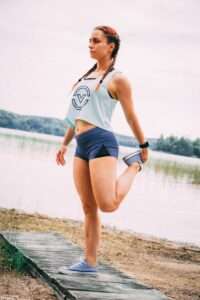 To improve flexibility and mobility, athletes and active individuals often rely on several forms of stretching.
To improve flexibility and mobility, athletes and active individuals often rely on several forms of stretching.
These involve lengthening or flexing a muscle or tendon to promote enhanced elasticity.
One method is active stretching, in which your own muscles are used to provide resistant pull, and this creates the stretch.
This article will detail active stretching, how it differs from other forms of stretching, and how to perform it.
What is active stretching?
Active stretching is a method of improving flexibility. It involves active contracting of one muscle (the agonist) as a way to stretch an opposing muscle (the antagonist), with no external force.
Active stretching is also often referred to as static active stretching — which means nonmoving — because the end position of the stretch is held for a set amount of time.
But instead of holding your stretch using a prop, such as a strap or band, you’re simply holding the stretch with other muscles. This is why it’s called static active stretching.
These stretches are commonly held for 10–15 seconds. Any longer tends to be quite difficult.
One example of active stretching is lying on your back on the floor and lifting a straight leg to the ceiling until you feel your hamstring stretch.
Holding that position without a strap requires active work from your hip flexors and core to keep your leg in the air, while your hamstrings — the muscles on the opposite side of the hip joint — are statically stretching.
This method of stretching is often performed after exercise, as some studies suggest a potential decrease in muscle strength and power when performing static stretching before a workout (1Trusted Source, 2Trusted Source).
If you practice yoga, you’re familiar with active stretching. Holding yoga poses requires strength in certain muscles while other, opposing muscles are being stretched.
SUMMARY
Active stretching is a method of improving flexibility, where strategically contracting your own muscles provides the pull needed to stretch opposing muscle groups.
How does active stretching differ from other types of stretching?
When it comes to stretching, numerous methods generally serve a similar function, though they differ slightly in execution.
So, it helps to distinguish which type of stretching is best for your goals. Here’s an overview of a few different types:
Passive stretching
While active stretching focuses on using one muscle group to stretch another, passive stretching uses an external force to provide the pull for the stretch.
The resistance pull can either be provided by another part of your body, by a partner, or by an object.
Similar to active stretching, you hold the position for a period of time.
Passive stretching is often utilized during recovery from exercise to relax your muscles and connective tissue.
Dynamic stretching
Dynamic stretching is a movement-based method of stretching in which a given body part is moved with control through its full range of motion — though not beyond it.
These movements are often sport–specific and performed prior to a training session as a warmup.
Some common examples include leg swings and shoulder circles.
Ballistic stretching
Ballistic stretching is similar to dynamic stretching in that it’s movement-based. Instead of moving a body part to the end of its range of motion, however, you attempt to go beyond this range.
These stretches often require uncontrolled movements that may result in injury. That’s why this method of stretching is generally not recommended for most people.
SUMMARY
While active stretching may seem similar to other methods, it differs in that the pull of resistance is provided by your own muscles. It’s commonly utilized after exercise to promote recovery.
How to do active stretching
Active stretching is quite simple to execute, though certain positions may take some practice.
This form of stretching is most often performed following exercise, as part of a mobility workout, or incorporated into a yoga session.
Considering that active stretching doesn’t require any special equipment, it can be performed virtually anywhere. Here’s how:
Chose a target muscle that you would like to stretch and select a corresponding pose.
Flex the agonist muscle, or muscle on the opposite side of the muscle being stretched.
Hold that position for around 10 seconds, or until you feel a stretching sensation in the target muscle.
If completing a bilateral stretch (including both legs or arms) you can repeat these steps for the other limb.
SUMMARY
Active stretching is performed by contracting the agonist muscle opposite of the muscle being stretched for approximately 10 seconds, until a stretching sensation is felt.
Examples of active stretches
Each of the four stretches below include information about the agonist muscle (which is the muscle doing the work) and the antagonist muscle (which is the muscle being stretched).
Active hamstring stretch
Targets: the hamstrings
Agonist: the hip flexors and core muscles
Antagonist: the hamstrings
How to:
Lie on your back. It may be helpful to place a pillow under your head. Straighten both legs along the floor.
Lift one leg up to the ceiling, keeping your leg straight, until you feel a hamstring stretch. Hold for 10–15 seconds.
If you notice your tailbone starting to tuck, lower the lifted leg slightly, or bend your bottom leg and place the foot on the floor for support.
Active triceps stretch
Targets: the triceps
Agonist: the biceps and shoulder muscles
Antagonist: the triceps
How to:
Stand up straight, with good posture. Reach one straight arm up to the ceiling without lifting your shoulder.
Bend the elbow, so that your hand is moving down behind your neck, reaching between the shoulder blades.
Aim to keep your elbow pointing to the ceiling and reach your hand further down your back for 10–15 seconds.
Active chest stretch
Targets: the chest muscles (pectorals) and biceps
Agonist: the deltoids, rhomboids, mid traps, and other back and shoulder muscles
Antagonist: the chest muscles and biceps
How to:
Stand up straight, with good posture. Reach both arms out to the side at 90 degrees, with straight elbows. It may increase the stretch to turn your palms forward or toward the ceiling.
Open the arms as wide as possible, so that they’re extended behind the body. Stop when you feel a stretch across the chest and front of your arms.
Hold for 10–15 seconds, aiming to keep your rib cage from flaring and your back from arching.
Active quad stretch
Targets: the quadriceps
Agonist: the hamstrings
Antagonist: the quadriceps
How to:
Stand tall with your feet hip distance apart, maintaining good posture and a neutral pelvis. You may want to place one hand on a wall or chair for balance.
Bend one knee, lifting the foot behind you, aiming to touch your butt. Keep the knee pointed down to the floor and aligned with your supporting knee.
Bringing the knee forward (flexing at the hip) will decrease the stretch. Hold for 10–15 seconds.
Written by Daniel Preiato, RD, CSCS on March 24, 2021 — Medically reviewed by Courtney Sullivan, Certified Yoga Instructor




